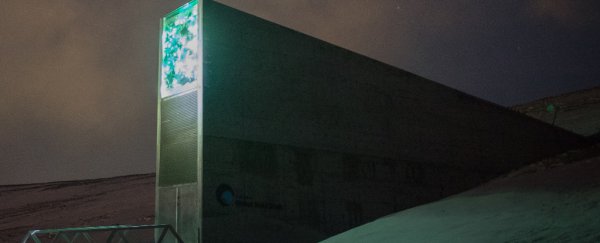Few places have served as a locus for the public's anxiety about climate change as much as the Svalbard Global Seed Vault.
The global seed ark, popularly known as the "Doomsday Vault", is embedded deep in the permafrost of a northerly Norwegian island and stores nearly a million samples from around the world for safekeeping in the event of war, famine, disease, and yes, climate change.
It backs up gene banks around the globe, a fail safe for the fail safes.
It is supposed to be indestructible, the frigid landscape serving as a natural coolant for the genetic material it protects.
And yet, climate change has been profoundly affecting the region, causing permafrost to melt, avalanches to strike, and, on one notable occasion, water to collect and freeze at the beginning of the tunnel to the vault.
That latter phenomenon led to a flurry of panicked headlines in 2017; on the Internet, where such events can take on an ominous significance, the pessimistic conclusion was that if the Doomsday Vault is doomed, so are we.
The vault is probably going to be okay. But its occasional troubles put a focus on a much bigger problem: its home is undergoing rapid change thanks to the warming climate.
A report on climate change in the Svalbard archipelago released this earlier year by the Norwegian Center for Climate Services and commissioned by the Norwegian Environment Agency states that "from 1971 to 2017, a warming of 3-5 degrees Celsius has been observed . . . with the largest increase in winter and the smallest in summer."
The estimated average temperature for Svalbard is -8.7 degrees Celsius.
"We know that the warming in this area has been very fast during the last five decades, seen in a global perspective," said Inger Hanssen-Bauer of the Norwegian Meteorological Institute, who was one of the editors of the study.
Currently, Svalbard's glaciers are "losing more ice through melting and calving than they are accumulating through snowfall," according to the report. "All of the well observed glaciers are shrinking."
The warming of the surrounding ocean "has halted sea ice from forming."
But the predictions for the future are even more stark. The report projects changes from a period of 1971-2000 until 2071-2100 based on various scenarios for global warming set out by the Intergovernmental Panel on Climate Change.
"Under medium to high scenarios for future climate emissions," the annual air temperature will increase by approximately 10 degrees Celsius under high emissions, and 7 degrees Celsius under medium emissions, scientists found.
That temperature increase will lead to drastic changes for the region, according to the report. Heavy rainfall will occur more frequently. Avalanches and mudslides will happen more often.
The snow season will become shorter. In the high-emission scenario, near-surface permafrost is predicted to melt in coastal and low-altitude areas.
The report does contain a caveat. "Inadequate knowledge of the climate system's sensitivity and of future natural climate variations, as well as limitations in the climate models, lead to large uncertainties in the projections even under a given emission scenario," the scientists wrote.
"It is still clear that reduced greenhouse gas emissions will lead to reduced changes in the physical climate."
The Svalbard archipelago, which about halfway between the mainland of Norway and the North Pole, is home to one of the northernmost human settlements on Earth, Longyearbyen.
The town is a hub for Arctic explorers and scientists, and home to the Global Seed Vault. The city has been experiencing anomalies, and occasional disasters, thanks to the changing climate.
Houses are cracking and shifting because of the melting permafrost, which destabilizes their foundations, CNN reported.
A 2015 avalanche killed two people and injured nine — the types of avalanches the Norwegian report say will increase in frequency if emissions aren't brought under control.
The Arctic overall has been highly susceptible to climate change. The National Oceanic and Atmospheric Administration's 2018 Arctic report card showed that "continued warming of the Arctic atmosphere and ocean are driving broad change in the environmental system in predicted and, also, unexpected ways."
The NOAA showed that surface air temperatures in the Arctic were warming at "twice the rate relative to the rest of the globe," among other concerning changes.
The IPCC has laid out stark projections for what catastrophes await the planet if global emissions are not curbed within the next few years. The problem is global in scale, and the proposed solutions can become mired in international politics.
If it's hard to keep focus, just think of the Doomsday Vault.
2019 © The Washington Post
This article was originally published by The Washington Post.
